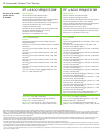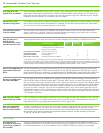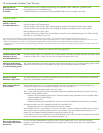
DIMM size/speed 512 MB 1 GB 2 GB
DDR2 667 MHz, ECC Available Available Not available
DDR2 800 MHz, ECC Available Available Available
4
What memory is used on the
HP xw4600? Is it the same
memory used on the HP
xw4400?
Yes and no. The HP xw4600 uses DDR2 800 unbuffered ECC memory technology for ECC memory configurations up to
8 GB, as well as DDR2 667 unbuffered ECC memory up to 4 GB. The HP xw4400 used DDR2 667 exclusively for all
configurations. HP offers you choices so that you can find the memory speed and configuration that meets your price and
performance needs.
Memory
Why do I sometimes see
memory in terms like
PC2-6400E? How does this
relate to memory bandwidth?
Clock rate is directly proportional to memory bandwidth. The bandwidth of 800 MHz DDR2 memory is calculated as 800
MHz x 8 bytes per channel = 6,400 MB/s or 6.4 GB/s. For simplicity, the value is thus referred to as PC2-6400 DDR
memory. The “2” after PC just identifies this memory as DDR2 memory. The “E” identifies it as ECC.This nomenclature is
sometimes more accepted in the industry.
The memory bandwidth of the system is improved upon by implementing dual-channel memory architecture. Above, notice
the factor ”8 bytes per channel.” By implementing two channels you can essentially double your bandwidth. Instead of a
single DIMM working alone, a pair of DIMMs essentially works together to split up the data exchange to and from the
rest of the system. On the HP xw4600 the dual-channel memory architecture results in unprecedented memory bandwidths
on a personal workstation. With PC2-6400E DDR (800 MHz) memory, the system’s theoretical memory bandwidth is an
impressive 12.8 GB/s.
Does the large DDR2 800
memory bandwidth (12.8
GB/s) really help system
performance if the processor
bandwidth is lower than
12.8 GB/s?
Yes. Not all data is transferred between the processor and the system memory. For some tasks, system I/O and graphics
pass data to the system memory. With the bandwidth headroom these tasks are carried out without interrupting the data
flow between the memory and the processor. In benchmarks, we’ve seen performance improvements as much as 5%
resulting from the faster memory. In addition, this performance gain scales with the processor. So, as the processors get
faster, the bandwidth benefit will become more important.
How does this memory
bandwidth impact the
HP xw4600 system
performance?
Many technical applications require huge amounts of memory bandwidth, especially those that use 3D graphics or that
have a large percentage of floating point calculations. These applications will benefit from the massive memory bandwidth
provided by the HP xw4600.
Memory latency is another very important factor. At the highest level, latency is a measure of how long it takes the
memory subsystem to respond to a cache miss in the processor. The lower (shorter) the memory latency, the better the
application performance, especially for applications that ”thrash the cache.”
Does the memory for the
HP xw4600 have to be
ordered in pairs? What is
the maximum memory
configuration?
To utilize the dual-channel memory architecture advantages, memory must be installed in pairs. However, a single DIMM
will work in the system (i.e., you could put 1x512 MB in the system). It is highly recommended that memory be added in
pairs, as the performance benefit is substantial. HP does offer two 1 x 512 MB configurations (both DDR2 667 and 800
MHz speeds) for cost-sensitive customers.
When installing memory in the HP xw4600, pairs must be matched in size and speed (i.e., 2x512 MB/800 MHz, not 1x512
MB/667, 1x1 GB/800) and multiple pairs must be matched in speed. The HP xw4600 has 4 DIMM slots (2 dual
channels) and supports up to 8 GB of physical memory.
Note: Configurations consisting of three memory modules are not supported by HP.
Does the HP xw4600 offer ECC
and non-ECC memory? What
speeds are offered?
No. The HP xw4600 offers ECC only. The following table outlines what memory is available.
What is ECC memory? Why is
ECC memory important?
“ECC” stands for Error Correcting Code or Error Checking and Correction. ECC memory modules have an extra chip that
performs a comparison of the data that is read in and written out. This chip has the capability of detecting single and
multiple bit errors and correcting single bit errors on the fly. If this extra chip detects a single bit error, it will correct the
discrepancy and the system will continue to function without any interruption. If a multiple bit error (which is extremely
uncommon) is detected, the memory module will issue a non-maskable interrupt (NMI) which will shutdown the system,
avoiding any data corruption in the system. Single and multiple bit data errors can go undetected without ECC memory.
Data integrity is always important, but when you are designing an airplane or automobile part, under a tight deadline on
your TV commercial production, analyzing population densities for domestic policy reform, or managing your clients’
financial portfolios of millions of dollars, data integrity is absolutely vital. And in today’s cutthroat competitive environment,
workflow efficiency and utilization rates are also crucial. All HP Workstations, including the HP xw4600, offer ECC
memory that provides an extra level of data integrity, reliability and greater system uptime.
HP recommends Windows Vista
®
Business












